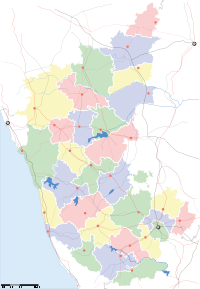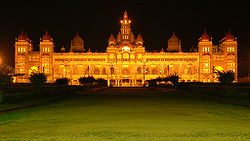- Portal:Karnataka
-
THE KARNATAKA PORTAL
I n t r o d u c t i o n
Karnātakā
 pronunciation (help·info) (Kannada: ಕನಾ೯ಟಕ) (IPA: [kəɹnɑːʈəkɑː]) is one of the four southern states of India. The state was created in 1956 with the passing of the States Reorganisation Act. Originally named state of Mysore, it was renamed as Karnataka in 1973. It is bordered by the Arabian Sea to the west, Goa to the northwest, Maharashtra to the north, Andhra Pradesh to the east, Tamil Nadu to the southeast, and Kerala to the southwest. The state covers an area of 1,91,791 km² or 5.83% of the total geographical area of India. It is the 8th largest Indian state by area, the 9th largest by population and comprises 30 districts. Kannada is the official and the most widely spoken language in the state.
pronunciation (help·info) (Kannada: ಕನಾ೯ಟಕ) (IPA: [kəɹnɑːʈəkɑː]) is one of the four southern states of India. The state was created in 1956 with the passing of the States Reorganisation Act. Originally named state of Mysore, it was renamed as Karnataka in 1973. It is bordered by the Arabian Sea to the west, Goa to the northwest, Maharashtra to the north, Andhra Pradesh to the east, Tamil Nadu to the southeast, and Kerala to the southwest. The state covers an area of 1,91,791 km² or 5.83% of the total geographical area of India. It is the 8th largest Indian state by area, the 9th largest by population and comprises 30 districts. Kannada is the official and the most widely spoken language in the state.Several etymologies have been suggested for the name Karnataka. One accepted derivative comes from the Kannada words karu and nādu meaning elevated land. Karu nadu may also be read as Karu (black) and nadu (region); as a reference to the black cotton soil found in the Bayalu Seeme region of Karnataka. During the British Raj, the word Carnatic or Karnatak was used to describe this part of the region in general. With an ancient and rich history that goes back to the paleolithic hand-axe culture, some of the most powerful empires of ancient India called this region home. Great philosophers and musical bards belonging to Karnataka launched socio-religious movements whose ennobling effects have been felt far and wide. Karnataka is the only state in India that boasts of significant contribution to both forms of Indian classical music, the Carnatic music and Hindustani music traditions. Kannada language has received the highest number of Jnanpith awards in India. Bengaluru, popularly known as the Garden city of India is today at the forefront of the rapid economic and technological development that India is experiencing.
Selected article
Profile of a Hoysala temple at Somanathapura
Hoysala architecture is the distinctive building style developed under the rule of the Hoysala Empire in the region known today as Karnataka, India, between the 11th and the 14th centuries. Hoysala influence was at its peak in the 13th century, when it dominated the Southern Deccan Plateau region. Large and small temples built during this era remain as examples of the Hoysala architectural style, including the Chennakesava Temple at Belur, the Hoysaleswara Temple at Halebidu, and the Kesava Temple at Somanathapura. Other examples of fine Hoysala craftmanship are the temples at Belavadi, Amrithapura, Hosaholalu and Nuggehalli. Study of the Hoysala architectural style has revealed a negligible Indo-Aryan influence while the impact of Southern Indian style is more distinct.[1]
The vigorous temple building activity of the Hoysala Empire was due to the social, cultural and political events of the period. The stylistic transformation of the Karnata temple building tradition reflected religious trends popularized by the Vaishnava and Virashaiva philosophers as well as the growing military prowess of the Hoysala kings who desired to surpass their Western Chalukya overlords in artistic achievement. Temples built prior to Hoysala independence in the mid-12th century reflect significant Western Chalukya influences, while later temples retain some features salient to Chalukyan art but have additional inventive decoration and ornamentation, features unique to Hoysala artisans. About one hundred temples have survived in present-day Karnataka state, mostly in the Malnad (hill) districts, the native home of the Hoysala kings.
As popular tourist destinations in Karnataka, Hoysala temples offer an excellent opportunity for pilgrims and students of architecture to examine medieval Hindu architecture in the Karnata Dravida tradition. This tradition began in the 7th century under the patronage of the Chalukya dynasty of Badami, developed further under the Western Chalukyas of Basavakalyan in the 11th century and finally transformed into an independent style by the 12th century during the reign of the Hoysalas. Medieval Kannada language inscriptions displayed prominently at temple locations give details of the temples and offer valuable information about the history of the Hoysala dynasty.
Selected picture
The Palace of Mysore is a palace situated in the city of Mysore, southern India. It was the official residence of the former royal family of Mysore, and also housed the durbar (royal offices). Mysore has a number of historic palaces, and is commonly described as the City of Palaces. However, the term "Palace of Mysore" specifically refers to one of these palaces, Amba Vilas. The palace was commissioned in 1897, and its construction was completed in 1912. It is now one of the most famous tourist attractions in Mysore. The Wodeyar kings built a palace in Mysore in the 14th century, but this palace was partially damaged by a lightning strike in 1638. It was repaired and expanded, but fell into neglect by the late 18th century. It was demolished in 1793, and a new palace was built in its place in 1803. This palace was destroyed in a fire in 1897 during the wedding of Princess Jayalakshmanni. The Queen-Regent of Mysore at the time, Kempananjammanni Vanivilasa Sanndihana, commissioned a British architect, Henry Irwin, to build yet another palace in its place. The architect was requested to combine different styles of architecture in the construction of the palace. The construction was completed in 1912. The palace apparently cost Rs. 42,00,000 to build at the time. The architectural style of the palace is commonly described as Indo-Saracenic, and blends together Hindu, Muslim, Rajput, and Gothic styles of architecture. It is a three-storied stone structure, with marble domes and a 145 ft five-storied tower. The palace is surrounded by a large garden.
References
- ^ Percy Brown in Kamath (2001), p134
Categories
Karnataka news
May 2010
- May_22: Air India Express Flight 812
May 2008
- Elections to 224 seats of Karnataka legislative assembly were held in three phases on 10,16 and 22 May 2008.
Jun - Jul 2007
- Jul_01: Karnataka bans the sale and production of arrack.
- Jun_25: Heavy rains claim 43 lives; mainly in the districts of Bagalkot, Bijapur and Raichur.
- Jun_21: Two new districts, Ramanagaram and Chikballapur are expected to be created shortly in Karnataka
- Jun_19: Heavy monsoon rains caused sea erosion in the coastal districts of Karnataka.
- Jun_15: The disease Chikungunya makes a comeback in Karnataka with 482 suspected cases being reported.
- Jun_11: Changi Airport Ltd. wants to jointly bid with Tatas for the development of airports at Shimoga, Gulbarga and Bijapur.
- Jun_08: President of India, APJ Abdul Kalam dedicates to the nation, India's latest communication satellite Insat 4-B at Hassan in Karnataka.
- Jun_07: Bangalore Bio-2007, a three day biotechnology show is inaugurated in Bangalore.
- Jun_05: U T Khader of the Congress party won the by-election held in the Ullal constituency of the Karnataka Legislative Assembly.
- Jun_05: The Government of Karnataka has allotted 300 acres of land in Dharwad for a project by Tata Motors.
Selected biography
Gubbi Veeranna (Kannada: ಗುಬ್ಬಿ ವೀರಣ್ಣ) was an Indian theatre director, one of the pioneers and most prolific contributors to Kannada theatre. He established the drama company, Gubbi Veeranna Nataka Company that played a crucial role in promoting the Kannada theatre. Some of the stalwarts that have emerged out of this company include Dr. Rajkumar, B. Jayashree and G. V. Shivananda. He is conferred the title Nataka Ratna meaning jewel in the theatre world. Gubbi Veeranna Nataka Company is the first theatre company in Karnataka to employ female artists to portray female characters on the stage. There is a popular saying that the story of Gubbi Veeranna's company is the story of the Kannada theatre which indicates the standing of this company in the theatre world. Apart from theatre, Gubbi Veeranna has also produced films and acted in them as well. Initially located in Gubbi, the company started to travel to different places and stage plays in those locations. The company had a troupe of more than 150 artists and backstage workers. Some popular plays staged by the company included Sadaarame and Yechamma Nayaka. These plays consisted of innovations like trick scenes, floods, clouds and rain. In those days, dramas used were staged for free with people only paying according to their liking at the end of the drama. However, Gubbi Veeranna's dramas were an exception with people willing to buy tickets to watch them. Most of the actors and actresses that entered the Kannada cinema world in those days were from this drama company.
Did you know...
The ten latest featured DYKs on Karnataka are:
- ... that Mysore mallige (pictured), a variety of Jasmine flower endemic to Karnataka state of India, is patented for its unique quality, attribution and reputation?
- ... that the Halegannada, literally Old Kannada, is an ancient form of the Kannada language?
- ... that as a result of the 2008 Karnataka state assembly elections the Bharatiya Janata Party formed its first state government in southern India?
- ... that although the Ishvara temple (pictured) in Karnataka, India, seems modest in construction, it is in fact the most complicated Hoysala monument?
- ... that although the Siddhesvara Temple (pictured) in Karnataka, India, is currently a temple of Shiva, historians are unsure of the faith to which it was originally dedicated?
- ... that the 9th century Navalinga temple in Karnataka, India, is a cluster of nine Hindu temples, each containing a Shiva linga?
- ... that a 12th-century epigraph styles the Mahadeva temple (pictured) in Karnataka, India, as "the emperor among temples"?
- ... that erotic sculptures (example pictured) found in the 11th century Tripurantaka Temple in Karnataka state, India, are miniatures?
- ... that the Tulu language speaking regions of Karnataka are called Tulu Nadu?
- ... that the Harihareshwara temple in Karnataka, India, was consecrated in 1224 CE, in dedication to Harihara (pictured), a fusion of the Hindu gods Shiva and Vishnu?
More...
Related portals
India
States: Goa • Gujarat • Maharashtra • Kerala • Tamil Nadu • West Bengal
Karnataka Cities: BangaloreKarnataka topics
Geography: Geography of Karnataka • Rivers of Karnataka • More
History: History of Karnataka • Vijayanagar Empire • Chalukya Dynasty • Hoysala • More
Districts and cities: Districts of Karnataka • Bagalkote • Bengalooru • Mysuru • More
Culture: Kodavas • Tuluvas • Cinema • People • Diwali • Dasara • More
Things you can do
- Help to build more Karnataka-related pages. There is a lot to be written about.
- Many Karnataka-linked pages need to be improved in content and depth.
- Actively rope in others from Karnataka as contributors to the Wikipedia.
- Contribute photos.
- Help to categorise and locate all the scattered links related to Karnataka on the Wikipedia.
WikiProjects
- WikiProject India - a project to improve all articles related to India.
- If you are interested in WikiProject Karnataka please join and start contributing..
Associated Wikimedia
Wikipedias in Indian languages
অসমিয়া (Assamese) • भोजपुरी (Bhojpuri) • বাংলা (Bengali) • ગુજરાતી (Gujarati) • हिन्दी (Hindi) • ಕನ್ನಡ (Kannada) • कॉशुर/كشميري (Kashmiri) • മലയാളം (Malayalam) • मराठी (Marathi) • नेपाली (Nepali) • ଓଡ଼ିଆ (Oriya) • ਪੰਜਾਬੀ (Punjabi) • संस्कृतम् (Sanskrit) • سنڌي (Sindhi) • தமிழ் (Tamil) • తెలుగు (Telugu) • اردو (Urdu) Categories:- WikiProject Karnataka
- Karnataka portal
- Karnataka
- India portals
- Portals under construction
Wikimedia Foundation. 2010.











